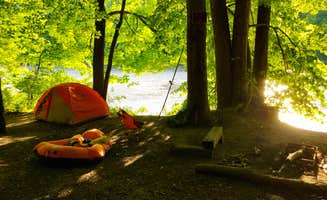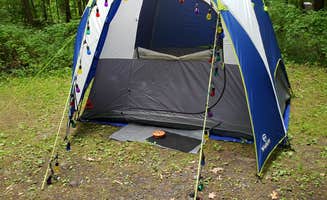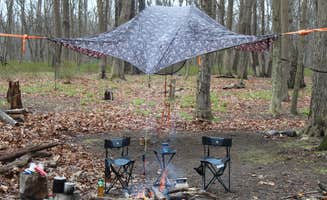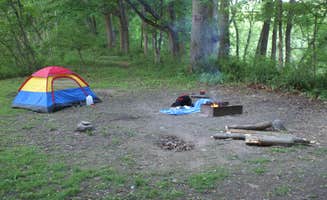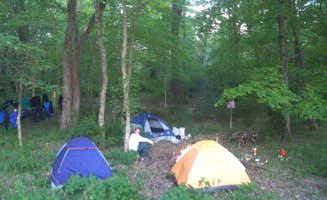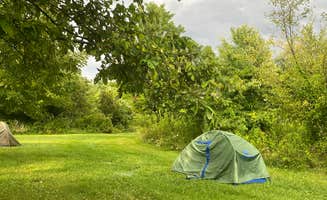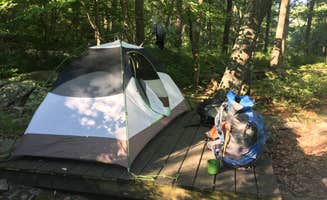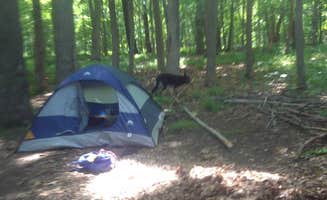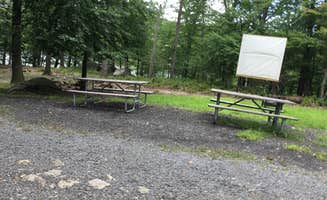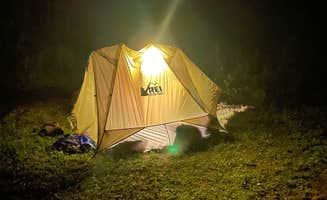Dispersed tent campsites near Matamoras, Pennsylvania offer direct access to the Delaware River and surrounding forested landscapes. The region sits at approximately 400-500 feet elevation with mixed hardwood forests dominating the landscape. Summer temperatures typically range from 75-85°F with periodic thunderstorms, while spring and fall camping periods feature cooler temperatures and reduced insect activity.
What to do
Waterfall exploration: 4-5 miles from campsites. At Namanock Island, campers can hike to nearby waterfalls after setting up camp. "There are waterfalls on the Pennsylvania shore within a quick walking distance of your location that are very much worth the time it takes to walk the trail," notes one visitor. Other falls are accessible with short drives or paddle trips.
Night sky viewing: Best in summer months. The absence of light pollution makes river camping ideal for stargazing. A camper at Namanock Island observed, "Once darkness falls there are no lights to be seen in either direction, up or down river... no lights means an incredible view of the night sky."
Fossil and artifact hunting: Year-round activity. The Delaware Water Gap area contains rich geological and historical features. At Sandyston Canoe Camping, visitors can "search for abandoned/forgotten homes and mills, some of which date back to the 1700's, or try your luck at fossil and artifact hunting."
Historic exploration: Self-guided tours available. The Delaware River region features significant historical sites. "This area is rich in history, folklore, legends and locations that anyone camping here would truly enjoy knowing/seeing," according to a Sandyston Canoe Camping visitor. Local historic bridges and structures date back hundreds of years.
What campers like
Island camping privacy: Limited sites available. On Steam Mill Campground, one camper reported, "I have now taken my packraft to the island twice and have had a fantastic trip each time! The sites are maintained by the NPS and are available on a first come first served basis." Riverside campsites offer unusual seclusion compared to developed campgrounds.
Cool morning temperatures: Even in summer. The higher elevation of campsites in the region results in comfortable sleeping weather. At Steam Mill, a visitor noted, "Sites are clean and the tables are in good condition. Fire rings don't seem centered on their cement bases, but other than being aware of the edges as a tripping hazard this is not an issue."
Spacious group sites: Can accommodate multiple tents. Several campsites across the region feature larger sites for groups. At Sandyston Canoe Camping, "We were very happy to see the openness of the sites. They were very large and while covered by 40+ ft trees were open enough to make you wish you brought more gear and people just because it would fit."
Wildlife viewing: Dawn and dusk best times. Camping near Matamoras provides opportunities to spot native wildlife. At Steam Mill Campground, one camper shared, "There are bears in this area, and while I've not seen one in the campground, I have seen them on the trails while staying here."
What you should know
Bear safety requirements: Food storage critical. Throughout the region, proper food storage is essential. At Steam Mill Campground, a visitor advised, "I store my food in my car overnight and toss garbage bags in the dumpster nightly as well."
Limited stay durations: Check specific site rules. Many river campsites restrict camping duration. A visitor to Namanock Island stated, "You are limited to one night on the island though as the expectation is that you will continue down river to other primitive sites."
Cell service limitations: Plan accordingly. Connectivity varies dramatically by location and carrier. A camper noted for Steam Mill, "Decent cell signal for texts or calls," but other areas have no service.
River level fluctuations: Affects landing and site access. Water levels impact campsite accessibility. "Due to fluctuating water levels all of the islands that are used for camping have a cut wall cliff style approach, but these sites have a very steep and above average height to the shoreline making unloading both more tiring and more of a hazard," reported a visitor at Sandyston.
Tips for camping with families
Shelter camping options: Alternative to tents. At Jenny Jump State Forest, families can book shelters instead of tent camping. "The 'shelter' is what we would describe as a 'cabin'; four walls, a roof, locking door, locking windows, large picture frame front window, four beds (two bunks), a wood burning stove, and a porch."
Site selection for restroom access: Important with kids. Choose sites near facilities when camping with children. At Jenny Jump, "Shelter 2 is a minute walk from the restroom with sink/shower and water. Shelters 7 & 8 are even closer while 4 & 5 are the furthest, maybe an extra 5 minutes walk?"
Trail access from campsites: No driving required. Many camping areas connect directly to trail systems. A Steam Mill Campground visitor explained, "The campground is along the Blue Loop trail, providing either an easy walk along the stream or an easy/moderate hike that connects to the AT with views at Sunrise Mountain."
Tips from RVers
Limited RV access: Small units only. Most campsites near Matamoras accommodate only small trailers or RVs. At Elks Brox Memorial Park, a visitor noted, "I would not drive an RV in here except maybe a small type trailer." The narrow access roads and limited turnaround space restrict larger vehicles.
Challenging road conditions: Check ahead. Access roads to many camping areas require careful driving. "I read a previous review that stated small cars stay away. I have a Nissan rogue and made it in no problem. It's .8 miles in on the right," reported an Elks Brox Memorial Park camper.
Solar power limitations: Consider alternatives. Heavily wooded sites limit solar charging capabilities. A visitor at Elks Brox Memorial Park mentioned, "I'm right across from the lake in amongst a copse of trees. Drawback solar is pretty much out."


